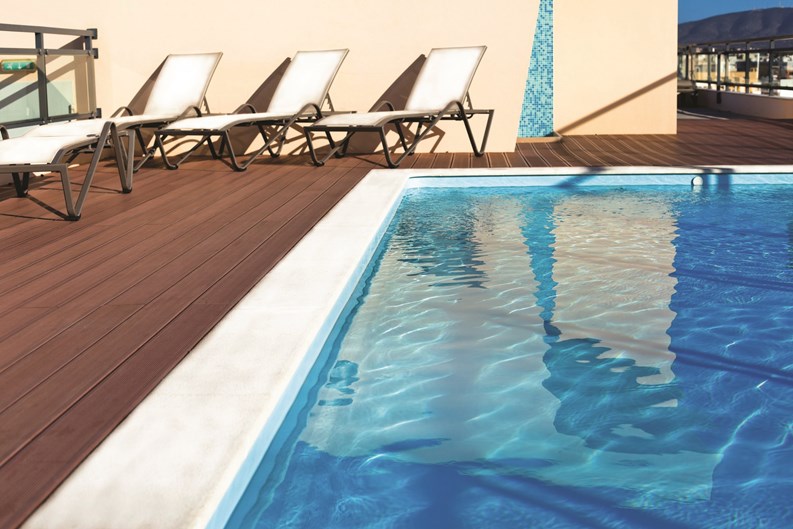Like beauty, what constitutes an 'amenity'—particularly a 'luxury' amenity—may well be in the eye of the beholder. Young families may want indoor and outdoor play equipment, while professionals may appreciate a well-appointed gym, and seniors might gravitate towards card rooms and social halls. All of those and more are examples of what may be considered an amenity, and whether built-in from the beginning or retrofitted later to meet resident demand, they add value—both real and perceived—to the properties that have them.
But with any amenity, be it something as simple as a basketball court or as complex as an indoor pool or rock climbing wall, comes potential liability. Making sure your building or association has enough of the right kind of insurance coverage for its amenities is a crucial part of your board/management team's job.
Not Your Grandma's Amenities
Swimming pools (indoors or out) well equipped gyms, recreation rooms and playgrounds are considered standard features by many. Hot tubs, saunas, roof decks, wine cellars, and concierge services are amenities with a definite lean toward luxury. Regardless of personal opinion on what is standard versus what's fancy, the first place to look for definition of an amenity is the association bylaws but you may not find one. “But don’t be surprised if you do not find a defined 'Building Amenities' description in the bylaws,” says Todd M. Ross, the managing director at One Point Brokerage, LLC in New York City. “Amenity space is really common space put to specific use for the benefit of the owners and residents of the building, and the term common space or common limited space is defined in the bylaws or proprietary lease. In today’s development terminology, amenities are meant to denote a special use of common space such as a pool, spa, wine room, movie room, or gym; it is more marketing terminology than insurance terminology,” he explains.
New and Improved Amenities
Generally, a community association provides insurance for the outside walls of habitational buildings, plus common areas (such as grass and walkways) surrounding the buildings. Brokers also note that coverage should also be included for the extras: things like a clubhouse, gazebo, swimming pool, storage areas, parking facilities, tennis courts, golf courses and any other areas owned by the association. The amenities, also known as the common elements, of a condo association will be defined in the building or association's offering plan, condo association declaration, and sales brochures. In a condo association apartment, they're defined in the building's occupancy agreement or proprietary lease.
“The building amenities are collectively owned by the unit owners, which is why they are referred to as common elements. A separate policy needs to be in force to cover this exposure,” says Joel A. Davis, regional marketing director at Community Association Underwriters of America, Inc., a nationwide insurer. “The coverage from an individual homeowner’s policy would be inadequate to cover all of the common elements. Ideally, the insurance agent for a homeowner should make certain that the homeowner’s policy only covers the unit owners’ property and that there are no gaps in coverage.”
Douglas Fenniman, CPCU, ARM, a senior vice president for Arthur J. Gallagher & Co. in New York City, says amenities these days can run the gamut from the traditional swimming pool or tennis court to “things that appeal to the younger generation, like roof decks with barbecues, children’s play areas, billiards/recreation rooms, and wine cellars.”
Determining Proper Coverage
No matter how it's defined in your governing documents, proper insurance of all amenities and common spaces is a must, says Ross. “Like any other common element and/or common space, a board is required to provide adequate insurance coverage for areas that they own and/or control.”
Unlike an urban jungle like New York City, traditional amenities found in suburban communities are resort-like in nature, and most often have swimming pools, tennis courts, golf courses, lakefront property, and the like, according to Chris Snow, principal owner of Bernier & Snow Insurance in Rochester, New Hampshire.
With pools, insurance coverage is essential, he says. “We are demanding that pools are compliant with the Virginia Graeme Baker Pool & Spa Safety Act, (which requires drain covers on all pools, spas and hot tubs.) Other than that, they want to make sure they’re fenced in, with a self-locking gate, that rules are posted, life safety equipment is nearby. Hopefully, they’d like to see that there is a phone to dial for help nearby. Lifeguards are not mandatory. Very rarely do you see lifeguards at a condo association pool.”
Some associations provide nature and walking trails while others have beaches and lakefronts in which they provide a variety of outdoor water sports. Make sure, he warns, that these activities are insured with stand-alone supplemental insurance, and that proper signage is posted for those using the amenities.
Amenities are underwritten for a certain fee, Snow says, but it varies by community and is included as part of a condo association or HOA’s overall insurance coverage. He notes that even purchasing as much as a $15 million umbrella policy would only cost an association from $2,000 to $3,000 annually, and is well worth the expense, he believes.
As for any advice he would offer, Snow says, “The more amenities you have, just make sure you have adequate limits. Like if you have a pool, a lot of attorneys suggest a minimum of $5 million dollars liability. If you only have $1 million and something happens, it may not be enough. Be sure your limits are adequate and just make sure all your signs are posted as to what a reasonable person does and make everyone aware of the exposures. That way you are protected.”
Is Basic Liability Enough?
Ross further cautions that an amenity can also bring increased liability and related risk. “Trip-and-falls, drowning, overheating, or something that's an 'attractive nuisance' to young children, are examples of increased liability,” he cautions. A board must also properly insure the entity against those types of liability related claims. “Regardless of the type of amenity a building may have or is thinking about putting in, proper property and/or liability coverage is necessary to transfer the risk to the party willing to handle it. In the case of an association, condo association, or HOA that is the insurance company as opposed to the shareholders, unit owners, or homeowners.”
Fenniman points out that general liability coverage will cover the building for claims against the association in which they are sued for bodily injury or property damage to a third party. “The coverage provides defense and indemnification. Boards should make sure they are covered from a liability perspective, third party, and also from a property perspective, first party. Coverage, on a replacement cost basis, should include loss from fire, theft, and flood in case the 'amenity' is damaged or destroyed.”
What Should be Covered?
Dan Wurtzel, president of FirstService Residential New York, a nationwide management firm, outlines the necessary coverages every condo association or HOA should have. “A typical placement for a community association policy should consist of general liability coverage, commercial property, equipment breakdown, and umbrella coverage,” he states.
And don’t forget about directors and officers insurance to cover the board of directors or board of trustees for allegations of wrongful acts. Other essential policies are fidelity bond or commercial crime insurance.
Fenniman recommends enough coverage for peace of mind. “If you and/or other board members are lying awake nights wondering 'how much coverage is enough?' it's time to call your agent to review your policies,” he says. “Generally speaking, we like to see a client carry limits in excess of the property value. With current umbrella risk purchasing groups offering limits up to $200 million, in some cases at very affordable prices, it makes sense to carry higher limits.”
Wurtzel notes that in New York City for example, many luxury high rise buildings opt to purchase as much as $200 million of liability coverage. That, however, might be too excessive for Garden State properties where you have smaller communities with less exposures to insure.
Work With Your Experts
Association boards will do well to use the experts available when buying, updating, or changing insurance coverage. Fenniman encourages that boards should make sure that the board to “Make sure the broker and the insurance company are always aware of the amenities to ensure proper coverage.” Ross notes that “bylaws require boards to carry adequate insurance for their property and operations. As a matter of corporate governance, insurance is required not so much for amenities per se, but for common elements and common space/area that comprise the association, condo association, or HOA.”
Ross also recommends consulting with not only the property insurance adjuster, but also the accountant and the attorney, for a truer picture of adequate property protection. “When price is the only consideration taken into account, you get what you pay for—in both product and services.”
So at the end of the day, nothing ensures peace of mind more than knowing you and your property are completely and adequately insured. That peace of mind, however, does come with a price tag, so board members and trustees must sharpen their pencils and take advantage of expert help and advice from trusted insurance professionals. n
Anne Childers is a freelance writer and a frequent contributor to The New Jersey Cooperator.





Leave a Comment